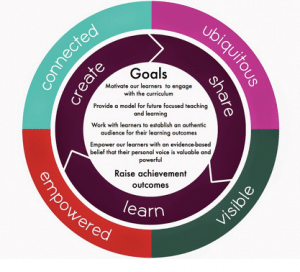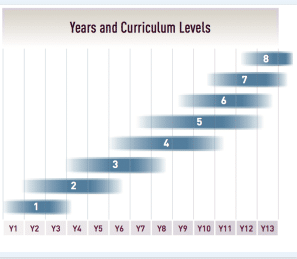Pt. England Primary: Manaiakalani, The Hook from Heaven
CompetencyWorks Blog
 This is the fifth article in the series Baskets of Knowledge from Aotearoa New Zealand, which highlights insights from a totally different education system about what is possible in transforming our education system. Read the first article here.
This is the fifth article in the series Baskets of Knowledge from Aotearoa New Zealand, which highlights insights from a totally different education system about what is possible in transforming our education system. Read the first article here.
A little background before I describe Pt. England Primary’s pedagogical approach and strategy for accelerating learning. New Zealand’s education system is designed around the assumption that students enter school at different points in their learning and development, and that learning does not occur in the same way or same pace. There are eight curricular levels outlined in the New Zealand National Curriculum that are bands stretching across three years with the expectation that students will be learning within those bands at a given age.
However, every educator I spoke to except two, Russell Burt, principal of Pt. England Primary, and Andy Kai Fong, principal at Haeata Community Campus, to some degree assumed that students who started at a lower level would end up at a lower level upon leaving school at the end of Year 13.

Don’t get me wrong – every school I visited had a clear focus on “priority” students who were not demonstrating as much growth as expected. However, there were few intentional strategies to make sure that students who started at an earlier stage on the curricular continuum would have an opportunity to graduate with the Level 3 certificate of achievement. One underlying reason for this is that the Tomorrow’s Schools policy, which grants wide reaching autonomy to schools, also means that no one has the responsibility of looking at how students are doing across the full 13 years of schooling within any one geographical area. (See article Why New Zealand? A Primer on the NZ Education System for description of key policies including Tomorrow’s Schools.)
Designing a Strategy for Acceleration
Pt. England’s pedagogical approach begins with respect and the assumption that students need to be actively engaged with minds turned on in their learning. The learning cycle – Learn, Create, Share – shapes the design of learning experiences. Students know that learning activities will likely culminate in a production of their ideas through a product, digital medium, arts, or performance.
The teachers at Pt. England launched the accelerated literacy learning model that developed into the Manaiakalani (The Hook from Heaven) cluster of thirteen schools. The model is based on “hooking” children’s interest in writing and reading. In other words, they wanted to create a high engagement approach in which students would be putting forth effort in their learning. Teachers seek to develop learning experiences that have the following features:
- Ubiquity: anywhere, anytime, any pace, any people learning
- Empowered: the power to act – informed/empowered/enabled learners
- Connected: edgeless education, connected minds
- Visible teaching and learning
The Learn, Create, Share learning cycle has expanded into a schoolwide approach applied to all disciplines at Pt. England.
The pedagogical principles underlying Manaiakalani learning cycle draw from three bodies of knowledge:
- Cultural responsiveness including Te Kotahitanga; (Scroll down Snaps from Aotearoa New Zealand to find more about the efforts of New Zealand to become bicultural.)
- eLearning; and,
- School improvement processes including micro-teaching.
The eLearning approach focuses on the learner experience in using digital technology as a medium for students to create, produce, and share their learning while building up foundational academic skills and not on how digital tools can provide direct instruction or embedded assessment as often emphasized in the U.S. By sharing on the internet what might have been a classroom activity gains authenticity as classmates and whānau (extended family) watch and comment on student blogs, videos, and podcasts.
Podcasts were the first medium used for students to share their ideas. As technology changed and reduced in price, the schools turned to blogs. In addition to podcasts, each class and each learner now has their own blog. As we walked around the school, I saw individual students and teams of students recording themselves. A special computer lab offers opportunity to create animations.
Pt. England uses iPads in Year 1-3, and Chromebooks for Year 5 and up are used for production as students demonstrate their learning. Please note: There is limited use of instructional programs to support skill-building. When asked about digital instructional programs, Burt replied, “We find a couple of skill drills helpful. But the problem is that if formative assessments don’t tell you something about the kids and how they learn, they are probably a waste of time. It’s not about getting the right answer. It’s about how students are learning.” Pt. England uses the Teacher Dashboard by Hapara, developed in conjunction with the Manaiakalani cluster of schools, to provide teachers with a way to monitor student work.
Burt shared insights about what they had learned in their “catch up and beyond” efforts. It usually takes three years of consistent use of the approach to see the impact of the approach. Most of the thirteen schools in the Manaiakalani regional cluster had learned how to accelerate one core subject at a time, but only one school had been able to accelerate all three.
The launch topic is writing, as they have learned to accelerate up to two times the national norm. He noted it can look like acceleration when the starting point is pretty terrible in terms of the instruction. Thus, schools may see a spike in acceleration the first year and, as the students get closer to the norm in terms of grade level expectations, the rate of acceleration will likely slow to 1.5 or 1.25.
He advised, “The trick is to do it at maths and reading at the same time. However, if your teachers aren’t prepared, it can be a big overload.”
They have found that improving writing didn’t immediately improve reading. However, focusing on reading will improve writing. So, why start with writing if it doesn’t have a catalytic effect? Writing is a demonstration and, with the power of the internet, becomes a public and collaborative forum. Students comment on each other’s blogs. Parents can see what their children are writing, and it even engages some parents in reading more themselves. It also creates purpose for reading. I read this book so I can write about it on my blog. And even more importantly, writing changes the culture as students find their voice, develop their voice, and begin to shape their environment by sharing opinions.
After watching a selection of videos and reading the blogs from students, it’s clear that this learning cycle is a powerful reinforcement for students to discover that both they and their voice are valuable. Once again, this practice links back to the core value of respect at Pt. England. (Please note, however, that Pt. England teachers think even more deeply about “voice”: It also means to engage deeply in concepts. In other words, student voice can mean engaging so deeply that personal meaning is developed and the learning becomes one’s own.)
The 2017 evaluation of the Manaiakalani programme found that across the schools there was “substantial acceleration” in years 4-10, especially in writing. If students received the “full dosage,” the rate of gain in writing was twice that expected nationally. The gains in reading and math have been significant but not at the levels of the gains in writing.
Thoughts on Scaling
“Our biggest enemy has been scalability” lamented Burt. In reflecting on the shift to what New Zealand refers to as modern pedagogy and the U.S. often refers to as personalization (both assume that technology are tools, not solutions), Burt noted that there had been several missteps. “One of the challenges is figuring out the right mix of experiences for your specific community of learners. We are very free to innovate in New Zealand, but it has led to idiosyncratic practices. It’s hard to learn from other schools because it isn’t one practice, it’s how they are put together.”
He explained that there were missteps when New Zealand schools tried to purchase evidence-based programs from the U.K. or the U.S. There was frequently a tension in how to integrate it with fidelity but within the context of their schools. Part of the problem is the narrow focus on academic metrics when schools need to develop the “learn to learn” skills such as growth mindset, agency, metacognition, and self-regulation. This is the same issue that Burt raised when he talked about New Zealand’s National Curriculum – when metrics are focused on the academics, it suggests that is what matters most, even though all the other aspects of pedagogy are most important to help children learn academics.
With Pt. England thinking more deeply about how to design a school that also engages and supports the broader community, Burt reflected, “We have to design with attention to evidence and scale. However, our trek is longer than it is at other schools because we are doing it at a community level.”
Read the Entire Series:
- Part 1 – Snaps from Aotearoa New Zealand
- Part 2 – Why New Zealand? A Primer on the NZ Education System
- Part 3 – Pt. England Primary: Making Sense of the New Zealand Curriculum
- Part 4 – Pt. England Primary: Creating a Culture of Respect, Belonging and Learning
- Part 5 – Pt. England Primary: Manaiakalani, The Hook from Heaven
- Part 6 – Pt. England Primary: Understanding Where Students Are
- Part 7 – Pt. England Primary: Gifting Language
- Part 8 – The Cherry or the Orchard
- Part 9 – Insights from Aotearoa New Zealand: Defining Lifelong Learning
- Part 10 – Insights from Aotearoa New Zealand: Key Competencies
- Part 11 – Insights from Aotearoa New Zealand: Credentialing Learning
- Part 12 – Insights from Aotearoa New Zealand: NCEA
- Part 13 – How Competency-Based is New Zealand?